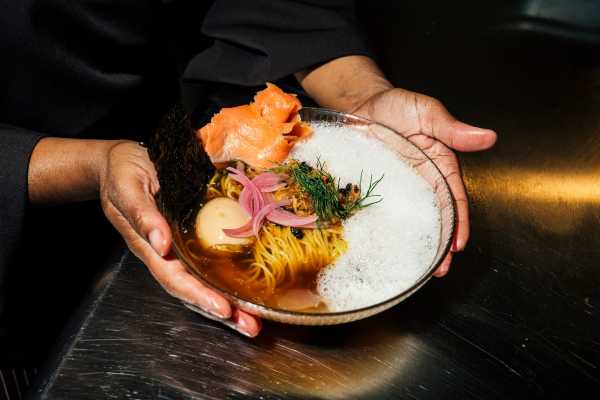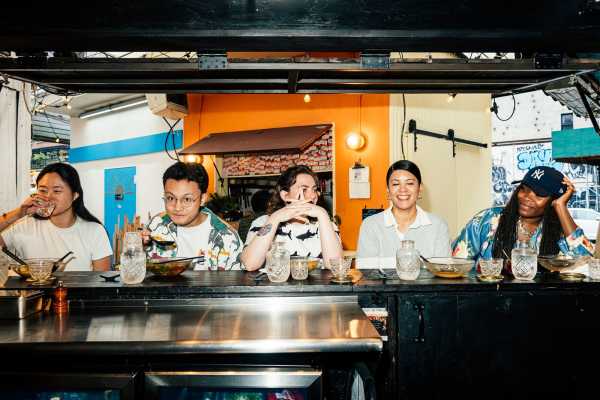
Save this storySave this storySave this storySave this storyYou’re reading the Food Scene newsletter, Helen Rosner’s guide to what, where, and how to eat. Sign up to receive it in your in-box.
In Japan, the most famous variety of asa-ra (breakfast ramen) is Shida ramen, named for the neighborhood in Fujieda city where it is said to have originated. The dish is a contrast in temperatures—one bowl of noodles in hot broth, one in cold—but it’s a “breakfast” dish mostly because of when it is served; the soup itself is more or less the same food as a bowl eaten any other time of day. At Ramen by Ra, a restaurant that opened late last year inside the Bowery Market, breakfast ramen is the only thing on the menu, served from 10 A.M. through a very un-breakfast-like 7 P.M. What makes it breakfast isn’t the clock but the flavors, which tell a story of morning in New York: there’s a bacon-egg-and-cheese ramen, a steak-and-eggs ramen, two bowls inspired by bagels, and another, brunchy version inspired by a B.L.T.
Purdie lifts and untangles noodles as she prepares a bowl.
Ramen by Ra, named for its owner, Rasheeda Purdie, is a one-woman operation. Along with being the namesake, Purdie is the head chef, sous-chef, host, captain, busser, and dishwasher. Such lean staffing is something of a necessity: the Bowery Market, a onetime auto-body shop on a busy NoHo corner, hosts four near-microscopic food stalls arranged around a broad open-air passageway. Ramen by Ra has just five seats, round stools set at a brief counter facing a tiny triangular kitchen that’s a squeeze for even one body. Meals are by reservation only, and when you book you’ll also be prompted to select your meal in advance, from a menu that features only the five ramens, plus optional add-ons and a small selection of teas and nonalcoholic elixirs. Purdie, who wears a half-apron tied at the waist and keeps her long, layered locks tied up in a scarf, moves fluidly from cooktop to convection oven to service counter, building each bowl. NoHo traffic blares and clangs all around, but watching her focussed, orderly preparations is hypnotically soothing: ladling broth, fluffing sliced scallions or chile threads, gently lifting and untangling noodles in a repetitive, ritualized process that feels both intimate and profound, like weaving on a loom, or carding wool.

The bagel-and-lox-inspired ramen.

Teas are served in glasses from Purdie’s mother.
All five varieties of ramen use the same noodles—chewy, straight, and thin, from the supplier Sun Noodle—and all begin with the same foundational broth, made with chicken stock and dashi. In the bowl, each dish is differentiated by the addition, à la minute, of flavorful fats, toppings, and sauces. The bacon-egg-and-cheese ramen, my favorite of the lineup, features a flutter of freshly grated Parmigiano, a gooey-yolked soy egg, and three thick, bronzed slices of bacon carefully shingled atop the noodles in a manner reminiscent of chashu. A splash of the bacon drippings, sizzling hot and gorgeously rich, is drizzled on straight from the frying pan just before serving, lending a bit of smoke and cured-meat funk to each slurp. A bagel-and-lox-inspired ramen folds a slice of cured salmon around the noodles, so that it gently cooks in the hot broth. It’s topped with a scattering of pickled red onions, crispy capers and shallots, and fresh dill, and a sudsy dollop of “cream cheese foam”—exactly what it sounds like, and oddly pleasing, with a gentle lactic tang that plays awfully nicely with briny notes of the nori oil that floats atop the broth. I preferred the other bagel-y option, the subtler (and considerably less salty) Everything Egg Drop, a culture collision of chewy noodles entwined with fluffy shreds of egg scrambled directly into the hot broth. Crunch and intensity come from a showering of the eponymous seasoning blend (dried garlic, onion, and sesame seeds) and a few silken, aromatic drops of toasted-sesame oil.

The tiny stall contains just five seats set at a counter.
Before becoming a chef, Purdie worked for a decade as a stylist at the late department store Henri Bendel, and on her lunch breaks she often went to a deli that had a ramen stand tucked in alongside the sandwich counter and salad bar. She became a ramen obsessive, but only later, after pivoting to a professional cooking career at places like Untitled at the Whitney, and Red Rooster Harlem, and pouring herself into ramen research, did she notice the parallels between traditional Japanese techniques and the Black American cooking of her grandmothers in North and South Carolina. There was the long, slow simmering; the use of bones and offcuts of meat; the layering of fats and aromatics. After mounting a few pop-ups that featured experiments like collard-greens ramen and chopped-cheese ramen, she homed in on the theme of New York City breakfast. She had become a fan of Kettl, a Japanese tea shop with a presence in one of Bowery Market’s minuscule retail spaces, and she told me that during her pop-up era she envisioned a permanent version of Ramen by Ra that had the same spare aesthetic. When a space in the market became available, she pitched herself to the landlord; the coming together of all the elements felt, she told me, “divine.”
Helen, Help Me!
E-mail your questions about dining, eating, and anything food-related, and Helen may respond in a future newsletter.
The teas Purdie serves alongside her ramen are Kettl’s—a bright ginger; a dusky hojicha and soba cha; a grassy, straightforward green. They’re poured from ornate pressed-glass decanters into similarly decorative glassware, heirlooms from her mother, which provide a visual counterpoint to the little restaurant’s otherwise dramatically minimalist décor. A grid of dark mounted shelves on the white walls contain only a vase of flowers, bowls and glasses, and a stack of three talismanic books: the iconic “Princess Pamela’s Soul Food Cookbook,” the scholarly volume “The Untold History of Ramen,” and “For the Culture,” the food writer Klancy Miller’s compendium celebrating Black women working in food—Purdie included. Places are set with chopsticks and spoons and, in warmer weather, discreet black-handled folding fans. Curious onlookers meander past, watching, over diners’ shoulders, as Purdie sweeps a dollop of garlicky parsley chimichurri over thin slices of magenta-rare rib eye in a bowl of steak-and-eggs ramen. It’s not “authentic,” in the sense of a bowl that instantly transports you to a Tokyo train station or a Fukuoka alleyway (head to Okiboru or Ramen Ishida, if that’s what you’re after), but authenticity comes in many forms; Purdie prepares her very personal, very New York version of asa-ra with knowledge and reverence, and a real sense of play. On each of my visits, someone passing by would ask if they could sit down in one of the empty stools. “I’m afraid you’ll have to make a reservation online,” Purdie would reply, with genuine warmth. “I hope I’ll see you soon!” ♦
Sourse: newyorker.com






